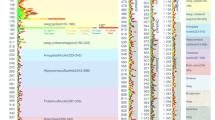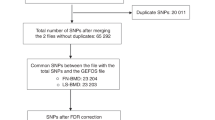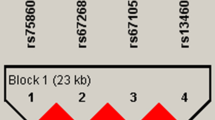Abstract
Twin and family studies had shown that genetic factors are important determinants of bone mass. Multiple genes might be involved. One candidate gene, the reversion-induced LIM gene (RIL), is a PDZ and LIM-domain-containing protein and has been localized within the cytokine cluster of chromosome 5 (5q31.1). In a genetic study of 370 adult Japanese women, we investigated the correlation between radial bone mineral density (BMD) and a genetic variation (−3333T→C) of the 5'-flanking region of RIL gene. A significant association was identified between the RIL variation −3333T→C and radial BMD (r=0.15, P=0.003). The variation of the RIL locus may be an important determinant of osteoporosis.
Similar content being viewed by others
Introduction
Osteoporosis is a multi-factorial common disease that is characterized by reduced bone mass and increasing risk of fracture. Genetic and environmental factors play important roles in the determination of bone mineral density (BMD) (Hirota et al. 1992; Suleiman et al. 1997; Pocock et al. 1987; Krall and Dawson-Hughes 1993).
Previous studies have examined associations of candidate gene polymorphisms with BMD. Examples are the genes encoding the vitamin D receptor, the estrogen receptor, the apolipoprotein E and type I collagen, combinations of which may determine individual BMD levels (Morrison et al. 1994; Melhus et al. 1994; Greenfield and Goldberg 1997; Kobayashi et al. 1996; Shiraki et al. 1997; Uitterlinden et al. 1998). In addition to these makers, numbers of unidentified polymorphic genes may participate in determining the bone mass of an individual. Candidates might be genes involved in cytokine-signaling pathways, the hormonal regulation of calcium balance and bone mineral, or the cellular function of bone cells.
One possible candidate gene localized within the cytokine cluster of chromosome 5 (5q31.1) is the reversion-induced LIM gene (RIL), whose mRNA expression in human bone marrow stromal cells has been strongly detected in a previous study (Bashirova et al. 1998). Although its exact function is not defined as yet, an involvement of osteoblast development/function is implicated.
In this study, we have carried out a correlation study of genetic variations in RIL gene for radial BMD levels. Involvement of an RIL gene polymorphism was tested with respect to the regulation of BMD.
Subjects and methods
Subjects
DNA samples were obtained from peripheral blood of 370 adult Japanese women (Shinohara et al. 2001). BMD was measured in all of these subjects. Mean ages and body mass indices (BMI) with standard deviations (SD) were 58.4±8.6 years (range: 32-69 years) and 23.7±3.61 kg/m2 (range: 14.7–38.5 kg/m2), respectively. All subjects were non-related volunteers and gave their informed consent prior to the study. No participant had medical complications or was undergoing treatment for conditions known to affect bone metabolism, such as pituitary diseases, hyperthyroidism, primary hyperparathyroidism, renal failure, adrenal diseases or rheumatic diseases, and none was receiving estrogen-replacement therapy.
BMD measurement
The BMD of radial bone (expressed in g/m2) in each participant was measured by dual energy X-ray absorptiometry (DEXA) with DTX-200 (Osteometer Meditech, Hawthorne, Calif., USA). To calculate the adjusted BMD, the measured BMD was normalized for differences in age and BMI by multiple regression analysis with the Instat 3 software package (GraphPad Software, San Diego, Calif.). The adjustment equation for the study samples was as follows: {adjusted-BMD (g/m2)} = {measured-BMD (g/m2)} − 0.006375 × [58.39 − {age (years)}] + 0.008961 × [23.65 − {BMI (kg/m2)}]. BMD in the distal radius was measured according to the Guidelines for Osteoporosis Screening in a health check-up program in Japan (Orimo et al. 2000). Although radial bone is not a first-choice measurement site for BMD in this program, we took advantages of radial BMD that represented the quality of both cortical bone thickness and cancellous bone volume when the distal part near the wrist joint was measured. This is suitable for dealing with large number of study participants and is rarely affected by old fractures, degenerative changes, or deformities.
Genotyping procedure
Genotypes of single-nucleotide polymorphisms (SNPs) were determined by using the SNP-dependent polymerase chain reaction (Sd-PCR) method, a refined allele-specific PCR to discriminate polymorphic sequences as described previously (Iwasaki et al. 2003). In brief, Sd-PCR transforms nucleotide differences (G, A, T, or C) between two alleles at a single site into size-differences between the respective alleles. The procedure incorporates double-nucleotide mismatches at the 3' end of polymorphic (forward) primers representing each allele, one mismatch corresponding to the natural SNP to be tested and the other being designed to allow distinct allelic discrimination through the almost exclusive amplification of one allele over the other. Two allele-specific primers (AS-primers) and one reverse primer were prepared per SNP as follows: RIL-FL: 5'-TTTTTGGGGCCTGGATCTGGCTCTTCGGAC-3', RIL-FS: 5'-CCGGCCTGGATCTGGCTCTTCCCAT-3', RIL-RS: 5'-GTTTAGCTGTGGCCACTGGGTAT-3'. The AS-primers (long and short) had a 5-base difference between them; each had the polymorphic nucleotide of the SNP sequence at the 3' ends and an additional artificial mismatch introduced near the 3' end. These primer sets allowed the distinct discrimination of alleles. Each genomic DNA sample (10 ng) was amplified with 250 nM each primer (two polymorphic forward primers and one reverse primer) in a 10-µl reaction mixture containing 10 mM dNTPs, 10 mM Tris-HCl, 1.5 mM MgCl2, 50 mM KCl, 1 U Taq DNA polymerase, and 0.5 mM fluorescence-labeled dCTP (ROX-dCTP; Perkin-Elmer, Norwalk, Conn., USA; Nakazawa et al. 2001). The Sd-PCR reaction was carried out on a thermal cycler (Gene-amp system 9600, Perkin-Elmer) with initial denaturation at 94°C for 4 min, followed by five cycles of stringent amplification (94°C for 20 s, 64°C for 20 s, 72°C for 20 s) and then 25 cycles of 94°C for 20 s, 62°C for 20 s, 72°C for 20 s), terminating with a 2-min extension at 72°C (Harada et al. 2001). Allele discrimination was carried out by electrophoresis and laser scanning of the DNA fragments on an ABI Prism 377 DNA system with GeneScan Analysis Software ver2.1 (Applied Biosystems, Foster City, Calif.; Hattori et al. 2002). To confirm the accuracy of the Sd-PCR method, direct re-sequencing was carried out by using the ABI Prism BigDye Terminator system (Applied Biosystems).
Statistical analysis
BMD data of each subject were normalized with age and BMI, by means of Instat 3 software package (GraphPad Software, San Diego, Calif.) via multiple regression analysis. Quantitative association between genotypes and adjusted BMD values (g/m2) was analyzed via one-way analysis of variance (ANOVA) with regression analysis as a post hoc test. Three genotypic categories of each SNP were converted into incremental values (0, 1, and 2) corresponding to the number of chromosomes possessing the minor allele. Significant association was defined when the given P-value of the ANOVA F-test was less than 5% (P<0.05; Ota et al. 2001). To ascertain the Hardy-Weinberg equilibrium among genotypes of the subjects, the chi-squared test was used (P>0.05).
Results
BMD association of the RIL gene locus was examined with RIL as one of the likely candidates for osteoporosis susceptibility genes. We first examined the polymorphic nature of a promoter SNP, −3333T→C, localized −3333 bp upstream from the translation initiation site of RIL and archived in the Japanese SNP (JSNP) database (referenced contig; NT_007072.10 from GenBank, Hs 79691 from Unigene) in 32 chromosomes of Japanese subjects. The SNP from the JSNP database turned out to be moderately polymorphic in the test population. Genotypes of the SNP were determined for all the 370 subjects, and an ANOVA with a linear regression test was performed. The distribution of SNP genotypes of the RIL gene in our subjects fitted the expectations of the Hardy-Weinberg equilibrium based on allele frequencies (chi-squared test, P=0.99).
The 5' flanking SNP −3333T→C revealed a significant correlation with a variation in radial adjusted BMD (r=0.15, P=0.003, n=370). The homozygous T-allele carriers had the lowest adjusted BMD (0.370±0.053 g/cm2, n=14), heterozygous individuals had an intermediate adjusted BMD (0.391±0.054 g/cm2, n=116), and homozygous C-allele carriers had the highest adjusted BMD (0.404±0.055 g/cm2, n=240), implying an allelic dose effect of this variation on influences on BMD (Fig. 1). The results suggest that genetic variation in RIL contribute to the development of osteoporosis. We hypothesized that the T-allele homozygote for RIL −3333T→C SNP is an important risk factor for decreased BMD in adult women.
Discussion
In the work reported here, we showed an association of the −3333 T/C SNP variation in the promoter region of the RIL gene with radial BMD in a population of adult Japanese women. Adjusted BMD was lowest in T/T homozygotes, intermediate among heterozygotes, and highest among C/C homozygotes in the test population. The data implied that variation in the 5' flanking region of the RIL gene might have affected bone metabolism in these women, eventually introducing a variation in BMD. A lowered BMD in adult women could be a result of the reduced acquisition of bone mass before maturation and/or accelerated bone loss.
Originally, the RIL gene was identified, in rat fibroblasts, as a candidate tumor suppressor gene that encodes a PDZ and LIM-domain-containing protein (Kiess et al. 1995). PDZ and LIM-domain-containing proteins (PDZ-LIM proteins) are a class of LIM-domain proteins. The proposed function of PDZ-LIM proteins is related to the organization of the plasma membrane of polarized cells, based on the indicated function of both domains in protein-protein interactions and the subcellular localization of these proteins in a specific domains of plasma membrane by binding to F-actin and related cytoskeleton structures (Boden et al. 1998; Cuppen et al. 1998).
Structural similarity (identity: 27%) of the RIL protein to the other member of the PDZ-LIM protein family, LIM mineralization protein-1 (LMP-1, also known as ENIGMA), implies a functional resemblance of these gene products. LMP-1 is induced by bone morphogenetic protein-6 and may mediate the regulation of the osteoblast differentiation program (Boden et al. 1998). Similarly, RIL might be involved in the regulation of osteoblast differentiation and bone formation. Functional studies of genetic variation(s) in the RIL gene will be required to elucidate these problems. Of course, one possibility that cannot be ruled out is that this variation may itself be in linkage disequilibrium with other unmeasured functional variants that lie at or near the RIL locus and that represent the true mechanistic basis for the associations. The RIL gene is localized within the cytokine cluster of chromosome 5. Genetic variations of this region may have to be evaluated thoroughly. In addition, functional studies may also be required. Other genes in the same signaling cascade also need to be scrutinized to clarify the molecular mechanism for PDZ-LIM domain family regulation in osteoblast differentiation.
In summary, we have shown a significant association of the −3333T→C variant in the 5' flanking region of the RIL gene with radial BMD in adult Japanese women.
References
Bashirova AA, Markelov ML, Shlykova TV, Levshenkova EV, Alibaeva RA, Frolova EI (1998) The human RIL gene: mapping to human chromosome 5q31.1, genomic organization and alternative transcripts. Gene 210:239–245
Boden SD, Liu Y, Hair GA, Helms JA, Hu D, Racine M, Nanes MS, Titus L (1998) LMP-1, a LIM-domain protein, mediates BMP-6 effects on bone formation. Endocrinology 139:5125–5134
Cuppen E, Gerrits H, Pepers B, Wieringa B, Hendriks W (1998) PDZ motifs in PTP-BL and RIL bind to internal protein segments in the LIM domain protein RIL. Mol Biol Cell 9:671–683
Greenfield EM, Goldberg VM (1997) Genetic determination of bone density. Lancet 350:1263–1264
Harada H, Nagai H, Tsuneizumi M, Mikami I, Sugano S, Emi M (2001) Identification of DMC1, a novel gene in the TOC region on 17q25.1 that shows loss of expression in multiple human cancers. J Hum Genet 46:90–95
Hattori H, Hirayama T, Nobe Y, Nagano M, Kujiraoka T, Egashira T, Ishii J, Tsuji M, Emi M (2002) Eight novel mutations and functional impairments of the LDL receptor in familial hypercholesterolemia in the north of Japan. J Hum Genet 47:80–87
Hirota T, Nara M, Ohguri M, Manago E, Hirota K (1992) Effect of diet and lifestyle on bone mass in Asian young women. Am J Clin Nutr 55:1168–73
Iwasaki H, Emi M, Ezura Y, Ishida R, Kajita M, Kodaira M, Yoshida H, Suzuki T, Hosoi T, Inoue S, Shiraki M, Swensen J, Orimo H (2003) Association of a Trp16Ser variation in the gonadotropin releasing hormone (GnRH) signal peptide with bone mineral density, revealed by SNP-dependent PCR (Sd-PCR) typing. Bone 32:195–190
Kiess M, Scharm B, Aguzzi A, Hajnal A, Klemenz R, Schwarte-Waldhoff I, Schafer R (1995) Expression of ril, a novel LIM domain gene, is down-regulation in HRAS-transformed cells and restored in phenotypic revertants. Oncogene 10:61–68
Kobayashi S, Inoue S, Hosoi T, Ouchi Y, Shiraki M, Orimo H (1996) Association of bone mineral density with polymorphism of the estrogen receptor gene. J Bone Miner Res 11:306–311
Krall EA, Dawson-Hughes B (1993) Heritable and life-style determinants of bone mineral density. J Bone Miner Res 8:1–9
Melhus H, Kindmark A, Amer S, Wilen B, Lindh E, Ljunghall S (1994) Vitamin D receptor genotypes in osteoporosis. Lancet 344:949–950
Morrison NA, Qi JC, Tokita A, Kelly PJ, Croffs L, Nguyan TV, Sambrook PN, Eisman JA (1994) Prediction of bone density from vitamin D receptor alleles. Nature 367:284–287
Nakazawa I, Nakajima T, Harada H, Ishigami T, Umemura S, Emi M (2001) Human calcitonin receptor-like receptor for adrenomedullin: genomic structure, eight single-nucleotide polymorphisms, and haplotype analysis. J Hum Genet 46:132–136
Orimo H, Hayashi Y, Fukunaga M, Sone T, Fujiwara M, Shiraki M, Kushida K, Miyamoto S, Soen S, Nishimura J, Oh-hashi Y, Hosoi T, Gorai I, Tanaka H, Igai T, Kishimoto H (2001) Diagnostic criteria for primary osteoporosis: year 2000 revision. J Bone Miner Metab 19:331–337
Ota N, Nakajima T, Nakazawa I, Suzuki T, Hosoi T, Orimo H, Inoue S, Shirai Y, Emi M (2001) A nucleotide variant in the promoter region of the interleukin-6 gene associated with decreased bone mineral density. J Hum Genet 46:267–272
Pocock NA, Eisman JA, Hopper JL, Yeates MG, Sambrook PN, Eberl S (1987) Genetic determinants of bone mass in adults. J Clin Invest 80:706–710
Shinohara Y, Ezura Y, Iwasaki H, Nakazawa I, Ishida R, Kodaira M, Kajita M, Shiba T, Emi M (2001) Linkage disequilibrium and haplotype analysis among ten single-nucleotide polymorphisms of interleukin 11 identified by sequencing of the gene. J Hum Genet 46:494–497
Shiraki M, Shiraki Y, Aoki C, Hosoi T, Inoue S, Kaneki M, Ouchi Y (1997) Association of bone mineral density with apolipoprotein E phenotype. J Bone Miner Res 12:1438–1445
Suleiman S, Nelson M, Li F, Buxton-Thomas M, Moniz C (1997) Effect of calcium intake and physical activity level on bone mass and turnover in healthy, white, adult women. Am J Clin Nutr 66:937–943
Uitterlinden AG, Burger H, Huang Q, Yue F, McGuigan FEA, Grant SFA, Hofman A, Johannes PTM, Leeuwen, Pols HAP, Ralston SA (1998) Relation of alleles of the collagen type I a1 gene to bone density and the risk of osteoporotic fractures in adult women. N Engl J Med 338:1016–1021
Acknowledgements
This work was supported in part by a special grant for Strategic Advanced Research on "Cancer" and "Genome Science" from the Ministry of Education, Science, Sports and Culture of Japan, by a Research Grant for Research from the Ministry of Health and Welfare of Japan, and by a Research for the Future Program Grant of The Japan Society for the Promotion of Science.
Author information
Authors and Affiliations
Corresponding author
Rights and permissions
About this article
Cite this article
Omasu, F., Ezura, Y., Kajita, M. et al. Association of genetic variation of the RIL gene, encoding a PDZ-LIM domain protein and localized in 5q31.1, with low bone mineral density in adult Japanese women. J Hum Genet 48, 342–345 (2003). https://doi.org/10.1007/s10038-003-0035-1
Received:
Accepted:
Published:
Issue Date:
DOI: https://doi.org/10.1007/s10038-003-0035-1
Keywords
This article is cited by
-
Genetic aspects of osteoporosis
Journal of Bone and Mineral Metabolism (2010)
-
The interaction of PTP-BL PDZ domains with RIL: An enigmatic role for the RIL LIM domain
Molecular Biology Reports (2005)




